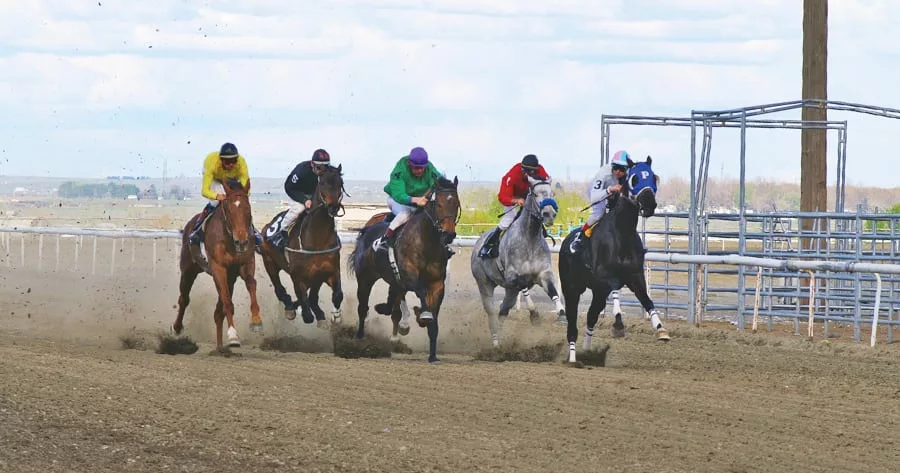
Home » Horse racing fans gear up for busy season at Sun Downs in Kennewick
Horse racing fans gear up for busy season at Sun Downs in Kennewick

April 13, 2017
Tri-City Horse Racing Association celebrates 30th year of racing at track
One of the three horse racing tracks in the Pacific Northwest opens for the season in Kennewick later this month.
[blockquote quote="Eastern Washington has a long history in horse racing, especially quarter horse racing. The commissioners want to keep it alive." source="Doug Moore, executive secretary of Washington Horse Racing Commission" align="right" max_width="300px"]
The annual race meet will run six dates over three weekends this spring – April 22, 23, 29, 30, May 6 and 7 – at the track at the Benton County Fairgrounds in Kennewick. The first race each day is scheduled to start at 1 p.m.
Highlights will include major challenge stakes races, and a celebration of the Kentucky Derby on May 6, in which fans can wager on the sport’s biggest race.
The challenge races are on the final weekend, either Saturday or Sunday. Winners of each challenge race, sponsored by the American Quarter Horse Association, will advance to the national finals this fall in Los Alamitos or Ruidoso Downs.
Admission is $5 and parking is free.
30th anniversary
Nancy Sorick, who heads up the nonprofit Tri-City Horse Racing Association, said she never thought about a legacy when she and eight other horse racing enthusiasts took over running Sun Downs race track in 1987.
“I guess we wanted to save the race track back then,” she said. “We didn’t want it to go away.”
The association celebrates its 30th season of racing at the Kennewick track.
Back in 1987, that local group of horsemen and women, owners and trainers approached Benton County about taking over running the track. The county didn’t want to be in the horse racing business anymore.
“We went to the county and offered to take over the track, paying the bills with a $40,000 trust account,” Sorick said.
Sorick is the only original member of the nine-person TCHRA still involved in the annual races.
And that longevity of 30 years is pretty impressive, considering the state of horse racing in the Pacific Northwest.
Over the last 30 years, tracks in Spokane, Yakima, Walla Walla, Dayton, Waitsburg and Les Bois in Boise have shut down.
Only Emerald Downs in Auburn, Portland Meadows and Sun Downs in Kennewick are still operating in the Pacific Northwest.
“But the weather was so horrific this winter that Portland had to cancel several days of racing,” Sorick said.
That bad weather did affect Sun Downs, which normally opens around Feb. 1 for trainers to prepare their horses.
Instead, the track opened Feb. 15.
‘New barns are filled’
Both Sorick and Shorty Martin, Sun Downs’ racing secretary, who sets the racing lineups during the meet, expect a large field of horses this season.
“All of our new barns are filled,” Sorick said. “The back side is probably three-quarters full overall. I’d say that we have about 100 head of horses out there.”
Martin expects at least 54 entries for the three challenge races.
“And we should have 35 to 40 entries for the Pot O’Gold,” he said.
The Pot O’Gold is the meet’s signature race, which usually features at least a $30,000 purse. It’s held on the final day of the meet.
That’s music to the ears of the commissioners of the Washington Horse Racing Commission.
“Our commissioners are fully in support of Sun Downs,” said Doug Moore, executive secretary of the commission. “Eastern Washington has a long history in horse racing, especially quarter horse racing. The commissioners want to keep it alive.”
Sun Downs, Moore said, has a great history.
“A lot of great trainers, horses and jockeys got their starts there,” Moore said. “From my perspective, that’s where people get their starts in the business, at tracks like Sun Downs. I equate it to a minor-league baseball system.”
Horse racing also brings money to the community.
During the race meet, the TCHRA employs 50 to 60 people, from program sellers to people working the wagering machines, to those working the gate.
The last independent economic impact statement for Sun Downs was done in 2005. It reported horse racing brought in $1.9 million to the community through hotel/motel stays, restaurants, feed stores, grocery stores and farming.
However, that was when the season spanned 10 days over five weekends. Now with the meet at six days over three weekends, the economic impact may be less than in 2005 but it is still a big contributor to the local economy, officials said.
“If we can be close to the last couple of years, we’ll be fine,” Martin said. “The last couple of meets have been successful. I think we’ve averaged $61,000 in total (money wagered) a day these last few years.”
Sorick has her usual goals for a great racing season.
“Have a good, clean race meet,” she said. “And a lot of horses. And everybody comes out and enjoys the races. And they have a good time.”
For more information, visit www.sundownshorseracing.com.
Local News
KEYWORDS april 2017





